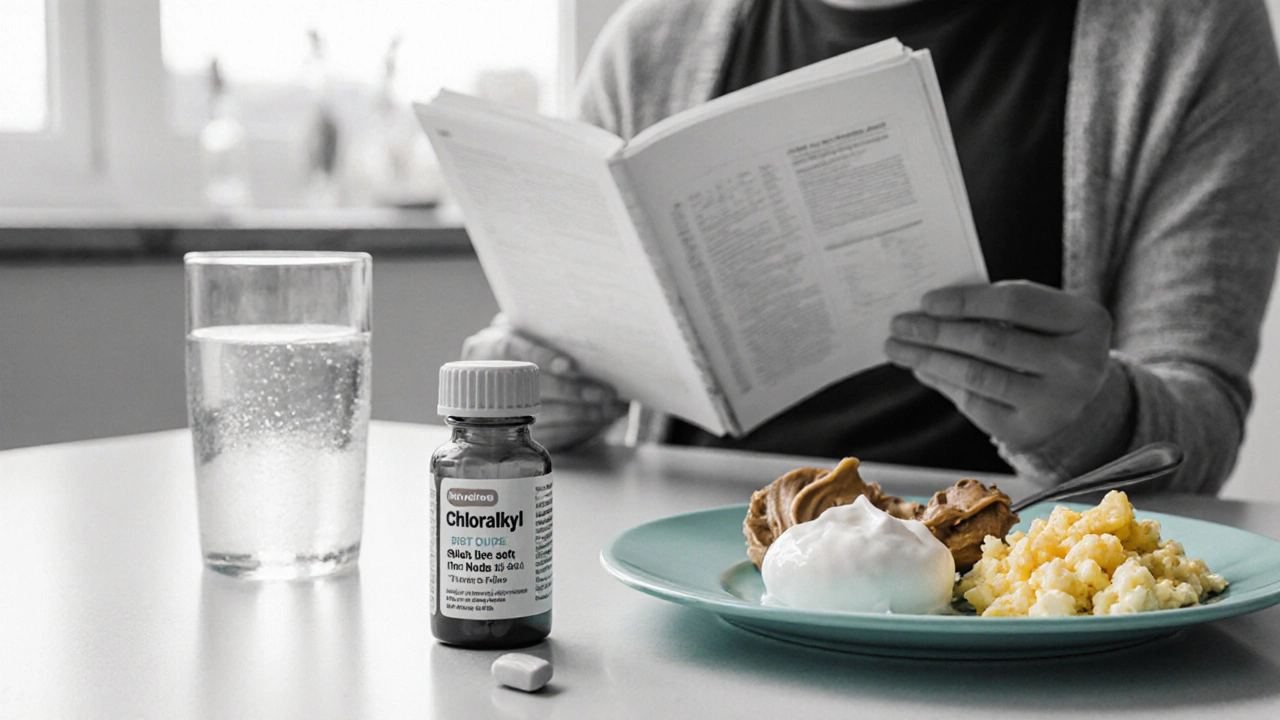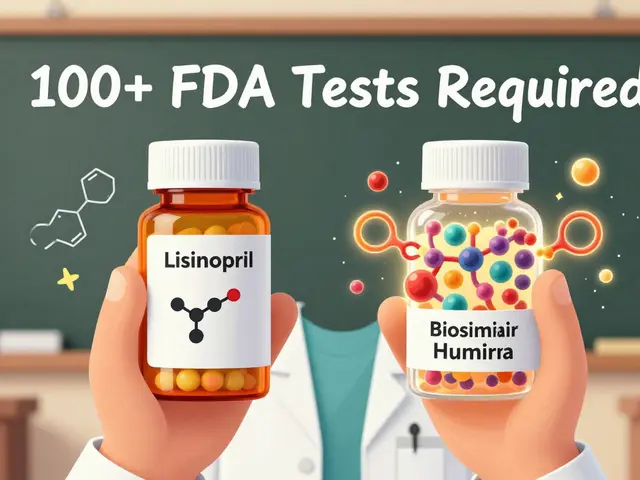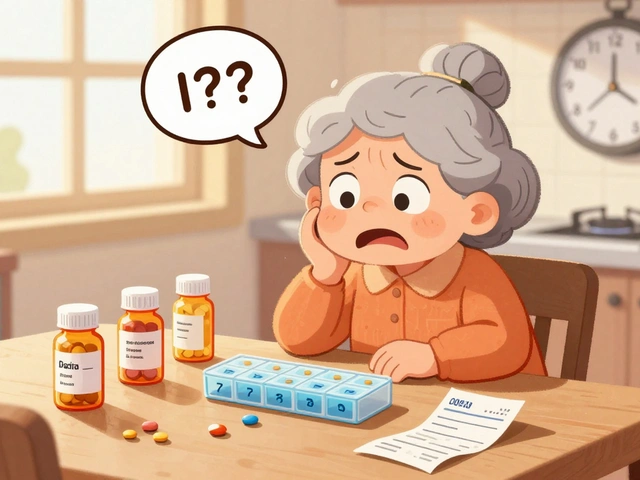Chlorambucil Diet Guide: What to Eat During Treatment

Chlorambucil Protein Calculator
Personalized Protein Calculator
Determine your daily protein needs to support blood cell production and tissue repair during chlorambucil treatment.
Your Protein Needs
Daily Protein Requirement: grams
Based on your weight and activity level during chlorambucil treatment.
What this means for you:
- Supports blood cell production and tissue repair
- Helps maintain muscle mass and prevent fatigue
- Essential for immune system function during treatment
Easy Protein Sources
High-Protein Foods
1 oz chicken breast = 7g protein
1/2 cup Greek yogurt = 10g protein
1/2 cup lentils = 9g protein
1 egg = 6g protein
Sample Meal Ideas
Breakfast: Scrambled eggs with cottage cheese
Lunch: Chicken salad with Greek yogurt dressing
Snack: Protein shake with almond milk
Dinner: Grilled salmon with steamed vegetables
Facing a chlorambucil regimen can feel overwhelming, especially when you wonder how every bite might affect your treatment. The good news? The right foods can ease side‑effects, keep your energy up, and support your body’s recovery. This guide walks you through the science, the best food choices, and practical tips so you can eat with confidence while on chlorambucil.
Understanding Chlorambucil
Chlorambucil is an oral alkylating agent commonly prescribed for chronic lymphocytic leukemia (CLL) and certain types of lymphoma. It works by attaching to DNA strands, disrupting cancer cell replication. Because it circulates through the bloodstream, the drug can also affect healthy, rapidly dividing cells, leading to side‑effects such as nausea, low blood counts, and mucosal irritation. Knowing how the medication interacts with your body helps you choose foods that protect healthy cells while not interfering with drug absorption.
Why Nutrition Matters During Chemotherapy
During any Chemotherapy a treatment that uses potent drugs to kill or stop the growth of cancer cells, your nutritional needs shift. Your body fights infection, repairs tissue, and manages the metabolic stress of the medication. A balanced intake of protein, calories, vitamins, and minerals can:
- Maintain muscle mass and prevent fatigue.
- Support a healthy immune system, especially crucial when chlorambucil lowers white blood cells.
- Reduce the severity of gastrointestinal side‑effects.
- Help your liver and kidneys process the drug more efficiently.
In short, eating well isn’t just about comfort-it’s a therapeutic ally.
Core Nutrition Principles for Chlorambucil Patients
These seven principles form the backbone of a chlorambucil diet that works:
- Prioritize protein. Aim for 1.2-1.5g of protein per kilogram of body weight each day. Protein fuels blood‑cell production and repairs tissue damage.
- Stay hydrated. Fluid loss from nausea or diarrhea can worsen kidney strain. Target 2-3liters of water daily, adjusting for activity level.
- Choose calorie‑dense foods. When appetite drops, foods like nut butter, avocado, and full‑fat dairy provide needed energy without large volumes.
- Focus on anti‑inflammatory nutrients. Omega‑3 fatty acids (salmon, flaxseed) can mellow treatment‑related inflammation.
- Include bone‑supporting nutrients. Chlorambucil can weaken bone marrow; calcium and vitamin D are essential.
- Limit irritants. Spicy, acidic, or high‑fiber foods may aggravate mouth sores or nausea.
- Eat small, frequent meals. This steadies blood sugar and reduces nausea spikes.
Key Nutrients and Their Food Sources
Below is a quick reference for the nutrients you’ll need most, plus the foods that deliver them efficiently.
| Nutrient | Why It Matters | Top Food Sources |
|---|---|---|
| Protein | Rebuilds blood cells & muscle | Lean chicken, turkey, Greek yogurt, lentils, tofu |
| Calcium | Maintains bone strength | Low‑fat milk, fortified plant milks, cheese, broccoli |
| VitaminD | Helps calcium absorption & immune function | Fatty fish, egg yolk, fortified orange juice, sunlight exposure |
| Omega‑3 | Reduces inflammation | Salmon, sardines, walnuts, chia seeds |
| VitaminC | Boosts immune defense | Citrus fruits, strawberries, bell peppers |
| Iron | Prevents anemia from low blood counts | Lean beef, spinach, beans, quinoa |

Foods to Embrace
These options are gentle on the gut, nutrient‑dense, and easy to incorporate into small meals.
- Soft proteins: Scrambled eggs, cottage cheese, well‑cooked fish, and tofu smoothies.
- Cooked vegetables: Steamed carrots, zucchini, and mashed sweet potatoes are easy to digest and packed with beta‑carotene.
- Whole‑grain porridges: Oatmeal with a spoonful of almond butter supplies fiber without raw grain roughness.
- Fruit purees: Applesauce, banana mash, and avocado puree provide vitamins and healthy fats.
- Hydrating soups: Bone broth, miso soup, or pureed vegetable soups add electrolytes and warmth.
Foods to Limit or Avoid
While every person reacts differently, these categories tend to trigger or worsen common chlorambucil side‑effects.
- Raw cruciferous veggies (broccoli, cauliflower) in large amounts: Their high fiber can cause gas and bloating.
- Spicy or acidic foods: Hot sauce, tomato‑heavy sauces, and citrus can irritate mouth sores.
- High‑sugar sweets: Quick energy spikes followed by crashes, and they may mask appetite for nutrient‑dense foods.
- Caffeinated beverages: Can increase dehydration and jitteriness.
- Alcohol: Interferes with liver metabolism of chlorambucil and worsens nausea.
Sample One‑Day Meal Plan
This plan respects the “small, frequent meals” rule, packs protein, calcium, and vitaminD, and stays easy on the stomach.
- Breakfast (7am): Greek yogurt parfait with a drizzle of honey, topped with soft berries and a sprinkle of chia seeds.
- Mid‑morning snack (10am): A small banana blended into a shake with fortified almond milk and a scoop of whey protein.
- Lunch (12:30pm): Warm quinoa‑lentil salad tossed with olive oil, roasted carrots, and a side of soft‑boiled salmon.
- Afternoon snack (3pm): Cottage cheese with peach slices and a handful of unsalted almonds.
- Dinner (6pm): Chicken broth‑based vegetable soup (celery, zucchini, sweet potato) plus a slice of whole‑grain toast with avocado spread.
- Evening snack (8:30pm): Warm oat milk with a pinch of cinnamon and a small piece of dark chocolate (70% cacao).
Adjust portions based on personal calorie needs; the goal is roughly 2,200-2,500kcal for most adults undergoing treatment.

Managing Common Side‑Effects Through Food
Chlorambucil can bring nausea, mouth sores, low blood counts, and fatigue. Here’s how diet can help.
- Nausea: Sip ginger tea or chew on crystallized ginger. Eat bland carbs (plain rice, toast) before a dose.
- Mouth sores: Choose soft, non‑acidic foods like mashed potatoes, scrambled eggs, and smoothies. Avoid salty chips and citrus.
- Low white‑blood‑cell count (neutropenia): Focus on zinc‑rich foods (pumpkin seeds, chickpeas) and vitaminC to boost immune response.
- Fatigue: Small protein‑rich snacks every 2‑3hours stabilize energy. Include complex carbs for sustained release.
Hydration & Supplement Guidance
Proper fluid intake aids kidney clearance of chlorambucil metabolites.
- Water: Aim for at least 8cups daily; add a slice of cucumber or lemon for flavor if plain water is unappealing.
- Electrolyte drinks: Low‑sugar options (e.g., coconut water) can replace salts lost through diarrhea.
- Supplements: Only take calcium, vitaminD, or multivitamins after consulting your oncologist. High‑dose antioxidants may interfere with chemo effectiveness.
Practical Tips for Real‑World Success
- Prep in batches: Cook a large pot of soup or quinoa on the weekend; freeze portions for quick reheating.
- Keep a food diary: Track what you eat, how you feel, and any side‑effects. Patterns will emerge, helping you fine‑tune the plan.
- Involve caregivers: Ask a partner or family member to help with grocery shopping and meal prep during low‑energy days.
- Stay flexible: If a specific food triggers nausea, swap it for another with similar nutrients.
Frequently Asked Questions
Can I take vitaminC supplements while on chlorambucil?
Moderate vitaminC from food is safe and may help immune function. High‑dose supplements (over 1,000mg per day) should be discussed with your oncologist because they could affect drug metabolism.
Is it okay to eat leafy greens during treatment?
Yes, but wash them thoroughly to avoid bacterial contamination, especially if your white‑blood‑cell count is low. Cooked greens like spinach or kale are easier on the stomach than raw salads.
Should I avoid dairy because of potential nausea?
Low‑fat dairy can be a good source of protein and calcium. If dairy feels heavy or triggers nausea, try lactose‑free or plant‑based fortified alternatives like soy or almond milk.
How much fluid is enough if I’m vomiting?
Sip small amounts (½ cup) every 10-15minutes rather than drinking large volumes at once. Oral rehydration solutions with electrolytes are ideal after vomiting episodes.
Can I follow a vegetarian diet while taking chlorambucil?
Absolutely, as long as you meet protein and iron needs. Include beans, lentils, tofu, tempeh, nuts, and fortified cereals. Pair iron‑rich plant foods with vitaminC to improve absorption.
Remember, nutrition is a personal journey, not a one‑size‑fits‑all prescription. Use this guide as a roadmap, talk openly with your care team, and adjust as you learn what your body tolerates best. Eating well can be a powerful part of your chlorambucil treatment plan, helping you stay stronger, feel better, and focus on recovery.
11 Comments
Mark Szwarc
Great rundown on the chlorambucil diet. I’d add that tracking protein intake with a simple spreadsheet can really help you hit that 1.2‑1.5 g/kg target. Also, don’t forget to spread meals out every 2‑3 hours to keep energy steady.
BLAKE LUND
Yo, this guide is like a culinary compass for the chemo journey! 🌈 The bit about swapping raw crucifers for steamed ones? Pure gold. Keep the vibes mellow and the soups soothing.
Veronica Rodriguez
Super helpful! 😊 I’ve found that a daily ginger tea really calms the nausea spikes, and adding a spoonful of almond butter to oatmeal keeps the calories up without feeling heavy.
Holly Hayes
Honestly, this piece reads like a textbook, but the tips are solid. i reckon the “soft proteins” line is key-scrambled eggs are easy on the gut and pack a punch.
Matthew Shapiro
Nice layout. One thing to remember: hydration isn’t just water-adding a splash of fruit‑infused water can make it more appealing, especially when taste buds are off.
Julia Phillips
What a beautifully crafted guide! The emphasis on small, frequent meals feels like a gentle hug for anyone battling fatigue. I especially love the suggestion to prep soups in bulk-pure comfort.
Richa Punyani
Dear reader, it is my pleasure to convey that the meticulous attention to calcium and vitamin D sources reflects a profound understanding of osteogenic health during chemotherapy. Kindly consider fortified soy milk as an alternative for those with lactose intolerance.
Bhupendra Darji
Thanks for the thorough list! I’d suggest adding roasted chickpeas as a crunchy snack-they’re high in protein and zinc, which can support neutrophil recovery.
Robert Keter
First off, kudos for pulling together such an exhaustive resource-it reads like a culinary bible for patients on chlorambucil. I want to highlight the critical role of omega‑3 fatty acids, not just for inflammation but also for maintaining cell membrane integrity, which can be compromised by alkylating agents. Incorporating a serving of wild‑caught salmon twice a week supplies EPA and DHA, the most bioavailable forms of omega‑3. If fish isn’t appealing, a tablespoon of ground flaxseed mixed into a morning smoothie delivers ALA, which the body can convert, albeit inefficiently, into EPA and DHA. Protein, as you noted, is paramount; however, spreading intake across the day prevents the body from catabolizing muscle during periods of low intake. Think of it like refueling a car at regular intervals rather than waiting until the tank is nearly empty. Regarding calcium, pairing it with vitamin D‑rich foods is essential because vitamin D enhances calcium absorption by up to 40 percent. A fortified orange juice alongside a serving of low‑fat cheese makes for a quick, synergistic snack. Hydration cannot be overstated-dehydration not only taxes the kidneys but also concentrates the urine, potentially increasing the risk of urolithiasis. Aim for 8‑10 glasses, but if plain water feels bland, a pinch of sea salt or a splash of cucumber water can encourage consumption. When it comes to managing nausea, the timing of meals matters; ingesting a bland carbohydrate like plain toast 15 minutes before taking chlorambucil can act as a buffer, reducing gastric irritation. For mouth sores, soft, non‑acidic foods such as mashed sweet potatoes or avocado puree mitigate discomfort while delivering essential micronutrients. Iron absorption is another hurdle; pairing iron‑rich legumes with vitamin C sources-think lentils with a squeeze of lime-greatly improves bioavailability, which is crucial given the risk of chemotherapy‑induced anemia. Lastly, I cannot stress enough the value of a food diary; recording not just what you eat but also how you feel helps identify patterns and refine the plan over time. In sum, this guide offers a robust foundation, and with these nuanced additions, patients can further optimize their nutritional status during treatment.
Rory Martin
While the guide is informative, one must consider the hidden agenda of pharmaceutical companies pushing supplements that may interfere with drug metabolism.
Maddie Wagner
This is a goldmine for anyone navigating chlorambucil. The practical tips about batch‑cooking soups and using electrolyte‑rich drinks are spot‑on. Remember, you’re not alone-support groups can share recipes that suit your taste buds and tolerance.






Write a comment